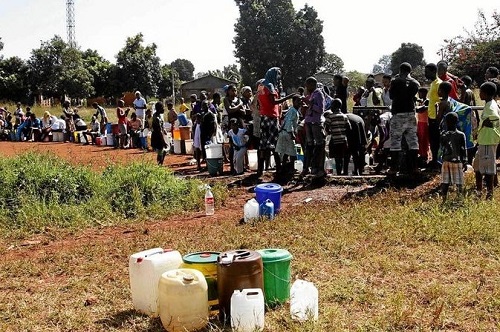EPA photo
By
Mbizo Chirasha
The stench of stale urine, rot and disease pervades the smoke ridden, dust laden air of the Zimbabwean townships. In these dwellings the population is high, the demand for water is soaring, while the precious liquid is fast dwindling and is in short supply in small cities and townships around the country.
Residents of southern suburbs of Harare, the most high-density locations of Budiriro, Glenview, Highfields, Mbare and Dzivaresekwa are facing rending water shortages. People in these areas are sitting on a time bomb of water-borne diseases like cholera, diarrhoea, typhoid and these locations have the highest rate of HIV/AIDS patients who require a lot of water for their hygienic upkeep. Clinics, which should offer treatment and good health service to the locals, also go for several days without running water that complicates the situation in the health delivery system.
Due to water budgeting and rationing by the city councils pupils go to school with unwashed uniforms and they have to spend the whole day without drinking water and without using toilets. Water is the greatest component of a sound sanitation system also impacting women and girls during their menstrual cycles. A lot of people in these locations resort to self-made wells whose water cannot be used for drinking and cooking but instead for washing and flushing ablutions. Such water is always contaminated by bilharzia bacteria. There were a few boreholes drilled by UNICEF between 2007 and 2008, only a few of these still existing as many have been vandalised by rogue locals that led to a serious water crisis ravaging town communities today.
The major cause of these acute water challenges is related to the previous year and present high temperatures which are beyond the usual range. These soaring temperatures, a clear indication of change in climate patterns, have impacted a great deal on the carrying capacity of water bodies that include rivers, lakes, dams, streams, boreholes and water wells. In December 2015 Zimbabwe was ravaged by a heatwave that affected a number of water sources including the main electricity and water supplier to the Zimbabwean populace, Lake Kariba. The temperatures during that period soared from 31 to 45 degrees Celsius and the water level of Lake Kariba decreased at a higher rate that further negatively impacted the livelihoods of the people. Lake Mutirikwi and Lake Chivero were also affected.
We are approaching another summer season under these critical circumstances and 2016 temperatures have taken an upward spiral, mostly during mid morning to evenings with daily maximum temperatures ranging from 33 degrees to 35 degree Celsius in hot and arid regions like Kariba, Hwange, Matebeleland south and Masvingo that are further dwindling the remaining water sources and posing a numbr of challenges such as dehydration, poor sanitation, unending droughts, loss of livestock, the domestic and industrial water crisis further worsening the already critical social and economic situation.
The Government, through its Cabinet Committee for Agriculture, reported that more than 160,000 beasts died in the 2015-2016 agricultural season due to acute water shortages and the EL Nino induced droughts and that the country requires $138 million to supplement for livestock feed and water supply. In accordance with sub section {1} of section 27 of the Civil Protection Act, the President of the Republic Zimbabwe on 14 February 2016 declared a State of Drought Disaster following the impact of El Nino induced erratic rainfalls and soaring temperatures. That state of nation required and requires cities and municipalities to bear the brunt of water rationing from the beginning of 2016 up to mid 2017.
A number of organisations which includes the United Methodist Committee on Relief {UMCOR} and ActionAid have responded and are responding to these climate change induced challenges through WASH, irrigation schemes and water harvesting projects. UMCOR is working in Mashonaland East while ActionAid is advancing assistance and projects in Manicaland. In addition Southern Africa Water Partnership in 2016 stepped up by setting up Youth Water Networks to develop ways in which the community organises methods of sustainable water conservation, harvesting and adaptation to these El Nino induced effects and has brought hope to communities in such dire circumstances. The Water Partnership is also partnering with governments in Southern and East Africa including Zimbabwe in drawing up Water Management Plans as a way of responding to these climate change induced crisis.
Given the above circumstances brought by the impact of climate change in Zimbabwe and other regions around the world, Zimbabwe needs to work with the global climate, energy and water community in advocating for scientific projects that reduce temperatures to reasonable ranges to avert water crisis, droughts, hunger and the negative impact on social, economic and moral lives of the Zimbabwean urban and rural populace.
Mbizo Chirasha
Mbizo Chirasha is an exiled Zimbabwean Poet, Writer and Citizens Justice Activist. He is the Founder of the Zimbabwe We Want Poetry Campaign whose Brave Voices Poetry Journal is regularly published by Tuck Magazine, while poems and the campaign are promoted at the Facebook Group, 100 Thousand poets for peace – Zimbabwe.
Mbizo’s Poetry can be found at http://www.mbizotheblackpoet.blogspot.ca/ and blog at http://personalitiesofinspiration.wordpress.com/ also.



No Comments Yet!
You can be first to comment this post!